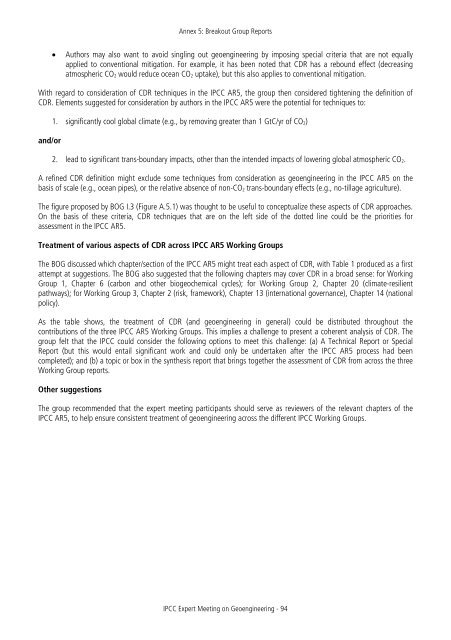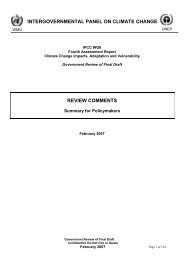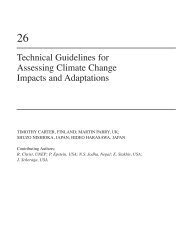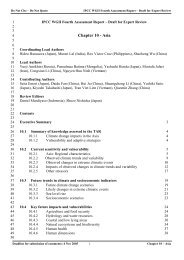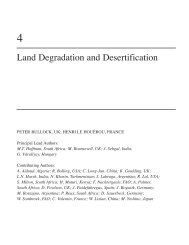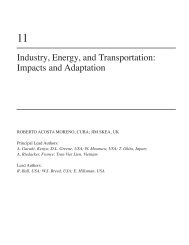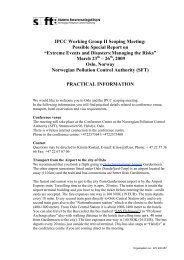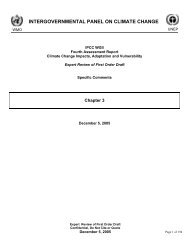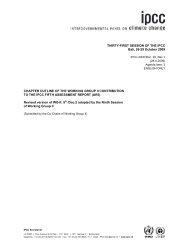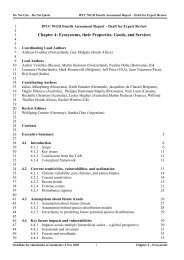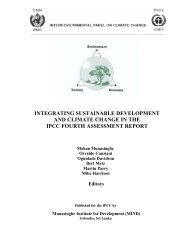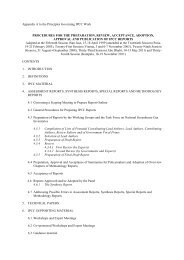IPCC Expert Meeting on Geoengineering
IPCC Expert Meeting on Geoengineering
IPCC Expert Meeting on Geoengineering
You also want an ePaper? Increase the reach of your titles
YUMPU automatically turns print PDFs into web optimized ePapers that Google loves.
Annex 5: Breakout Group Reports<br />
<br />
Authors may also want to avoid singling out geoengineering by imposing special criteria that are not equally<br />
applied to c<strong>on</strong>venti<strong>on</strong>al mitigati<strong>on</strong>. For example, it has been noted that CDR has a rebound effect (decreasing<br />
atmospheric CO 2 would reduce ocean CO 2 uptake), but this also applies to c<strong>on</strong>venti<strong>on</strong>al mitigati<strong>on</strong>.<br />
With regard to c<strong>on</strong>siderati<strong>on</strong> of CDR techniques in the <str<strong>on</strong>g>IPCC</str<strong>on</strong>g> AR5, the group then c<strong>on</strong>sidered tightening the definiti<strong>on</strong> of<br />
CDR. Elements suggested for c<strong>on</strong>siderati<strong>on</strong> by authors in the <str<strong>on</strong>g>IPCC</str<strong>on</strong>g> AR5 were the potential for techniques to:<br />
and/or<br />
1. significantly cool global climate (e.g., by removing greater than 1 GtC/yr of CO 2)<br />
2. lead to significant trans-boundary impacts, other than the intended impacts of lowering global atmospheric CO 2.<br />
A refined CDR definiti<strong>on</strong> might exclude some techniques from c<strong>on</strong>siderati<strong>on</strong> as geoengineering in the <str<strong>on</strong>g>IPCC</str<strong>on</strong>g> AR5 <strong>on</strong> the<br />
basis of scale (e.g., ocean pipes), or the relative absence of n<strong>on</strong>-CO 2 trans-boundary effects (e.g., no-tillage agriculture).<br />
The figure proposed by BOG I.3 (Figure A.5.1) was thought to be useful to c<strong>on</strong>ceptualize these aspects of CDR approaches.<br />
On the basis of these criteria, CDR techniques that are <strong>on</strong> the left side of the dotted line could be the priorities for<br />
assessment in the <str<strong>on</strong>g>IPCC</str<strong>on</strong>g> AR5.<br />
Treatment of various aspects of CDR across <str<strong>on</strong>g>IPCC</str<strong>on</strong>g> AR5 Working Groups<br />
The BOG discussed which chapter/secti<strong>on</strong> of the <str<strong>on</strong>g>IPCC</str<strong>on</strong>g> AR5 might treat each aspect of CDR, with Table 1 produced as a first<br />
attempt at suggesti<strong>on</strong>s. The BOG also suggested that the following chapters may cover CDR in a broad sense: for Working<br />
Group 1, Chapter 6 (carb<strong>on</strong> and other biogeochemical cycles); for Working Group 2, Chapter 20 (climate-resilient<br />
pathways); for Working Group 3, Chapter 2 (risk, framework), Chapter 13 (internati<strong>on</strong>al governance), Chapter 14 (nati<strong>on</strong>al<br />
policy).<br />
As the table shows, the treatment of CDR (and geoengineering in general) could be distributed throughout the<br />
c<strong>on</strong>tributi<strong>on</strong>s of the three <str<strong>on</strong>g>IPCC</str<strong>on</strong>g> AR5 Working Groups. This implies a challenge to present a coherent analysis of CDR. The<br />
group felt that the <str<strong>on</strong>g>IPCC</str<strong>on</strong>g> could c<strong>on</strong>sider the following opti<strong>on</strong>s to meet this challenge: (a) A Technical Report or Special<br />
Report (but this would entail significant work and could <strong>on</strong>ly be undertaken after the <str<strong>on</strong>g>IPCC</str<strong>on</strong>g> AR5 process had been<br />
completed); and (b) a topic or box in the synthesis report that brings together the assessment of CDR from across the three<br />
Working Group reports.<br />
Other suggesti<strong>on</strong>s<br />
The group recommended that the expert meeting participants should serve as reviewers of the relevant chapters of the<br />
<str<strong>on</strong>g>IPCC</str<strong>on</strong>g> AR5, to help ensure c<strong>on</strong>sistent treatment of geoengineering across the different <str<strong>on</strong>g>IPCC</str<strong>on</strong>g> Working Groups.<br />
<str<strong>on</strong>g>IPCC</str<strong>on</strong>g> <str<strong>on</strong>g>Expert</str<strong>on</strong>g> <str<strong>on</strong>g>Meeting</str<strong>on</strong>g> <strong>on</strong> <strong>Geoengineering</strong> - 94


